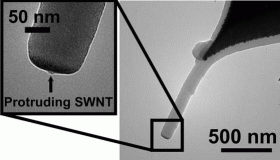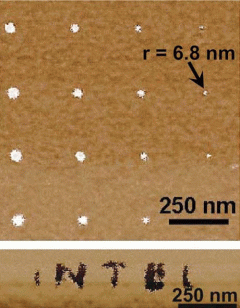September 22, 2008 feature
Nanopencil Can Provide Terabit Data Storage Density

(PhysOrg.com) -- Scientists have fabricated a 'nanopencil' with a tip so small that it can be used as a scanning probe in ultrahigh-density computer data storage systems.
The probe’s tip can write bit sizes with radii as small as 6.8 nanometers, allowing for a nonvolatile memory density of 1 Tbit/in2. With improvements, such technology has been predicted to realize storage density of 10 Tbits/in2.

This isn’t the first time that carbon nanotubes have been used as scanning probes for writing and reading data. However, the researchers, consisting of a team from Intel Corporation in Santa Clara, California, and the California Institute of Technology in Pasadena, California, made some improvements to enhance the performance and lifetime of the device.
While carbon nanotubes have strong mechanical and wear-resistant properties, one of the biggest challenges of using nanotubes as data storage read-and-write devices is that they’re still prone to bending and buckling after significant use. By coating the carbon nanotube with a 65-nm-thick layer of silicon-oxide, the researchers discovered that they could greatly increase the probe’s mechanical strength. In a sense, the improvement is the equivalent of putting wood around a long, thin stick of graphite in a regular pencil. After depositing the protective silicon-oxide sheath, the researchers used a diamond to “sharpen” the nanopencil to expose the carbon nanotube electrode.
When the scientists applied 100-microsecond electric pulses through the carbon nanotube, the electrode tip could write tiny dots on a 50-nm-thick ferroelectric film (the researchers used lead zirconate titanate). The electric pulses create electric fields underneath the nanopencil that flip the polarization of points on the ferroelectric surface, creating tiny domains of flipped polarization. The smaller these domains, the closer together they can be, allowing the system to store more data.
Due to the supportive sheath around the nanotube, the device can be made longer without worrying about it breaking. Compared with “naked” nanotubes with lengths of 100 nanometers, the new probes could be 1-2 micrometers long. Due in part to its length, the researchers estimated that a 1-micrometer-long nanopencil could scan 11.5 km of film without losing its resolution, which exceeds the requirements of most data storage applications. As coauthor Yuegang Zhang of Intel explained, after its initial sharpening, the nanopencil doesn’t need to be regularly sharpened like a graphite pencil.
“This is different from the case of normal pencil where the lead core wears much faster than the outer wood,” he said to PhysOrg.com. “In a normal pencil, graphite is consumed for recording, so extra sharpening is needed after some writing. In our nanopencil, writing is electrical, so no consumption of the nanotube is required in the ideal case. Although the wear occurs anyway, the nanotube core wears much slower than the silicon-oxide sheath, so the normal scanning operation of the device is a self-sharpening process. Another important difference is that the nanotube diameter keeps constant (not increasing) as it wears, not like the normally tapered pencil tip or conventional AFM tip.”
Zhang added that the team has plans to improve the nanopencil fabrication process to make it more reproducible in the future.
More information: Tayebi, Noureddine; Narui, Yoshie; Chen, Robert J.; Collier, C. Patrick; Giapis, Konstantinos P.; and Zhang, Yuegang. “Nanopencil as a wear-tolerant probe for ultrahigh density data storage.” Applied Physics Letters 93, 103112 (2008).
Copyright 2008 PhysOrg.com.
All rights reserved. This material may not be published, broadcast, rewritten or redistributed in whole or part without the express written permission of PhysOrg.com.




















